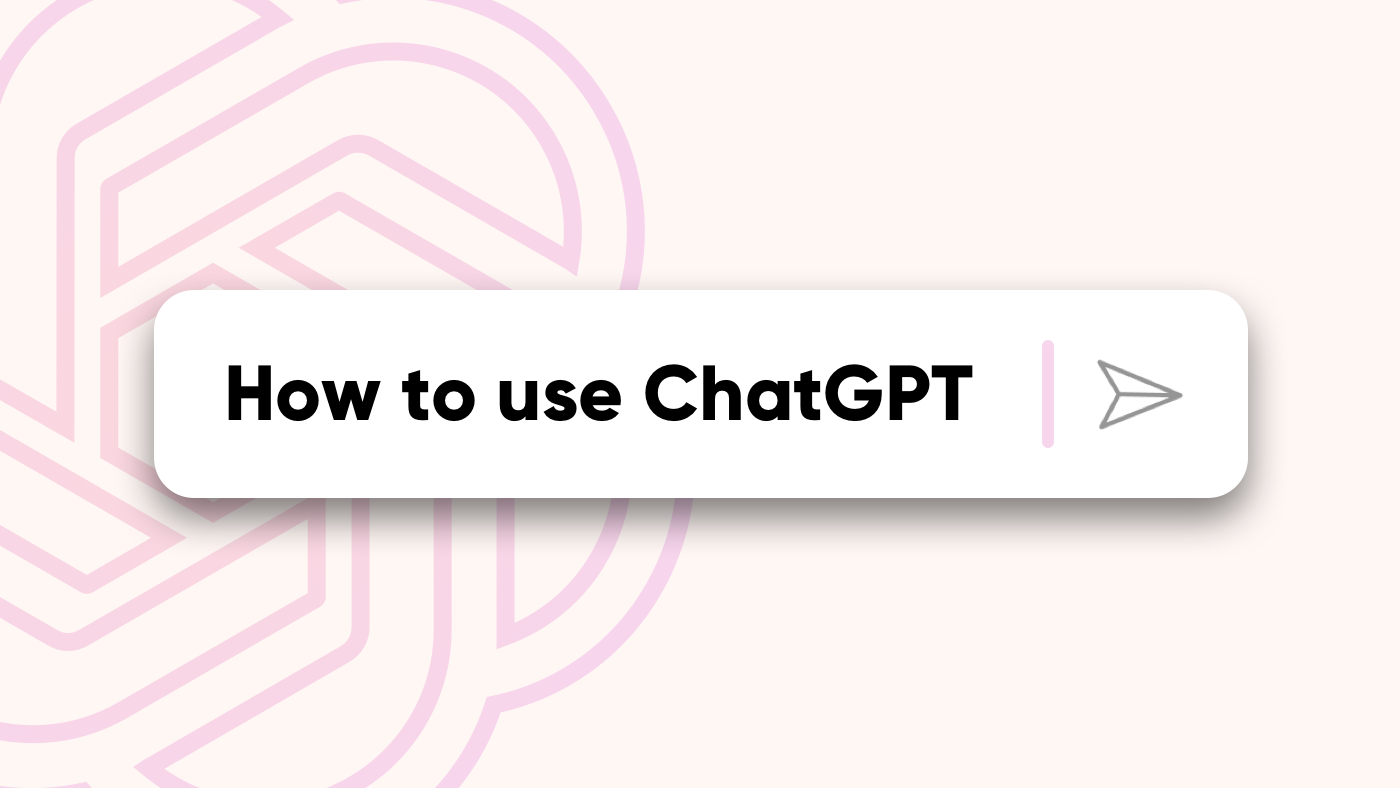During the widespread power outage across the Iberian Peninsula this year, transportation and communications were disrupted, and I suddenly realized how “dark” our lives would be without electricity and the internet.
We seem to have long been accustomed to the changes brought about by the internet, yet the next wave is already upon us, with AI rapidly becoming an integral part of our lives. In particular, AI tools like ChatGPT can listen, respond, assist us in our work, and even provide inspiration during creative processes.
Now that GPT-5 has been released, if you are still unfamiliar with ChatGPT or unsure how to use it, don't worry. This article will introduce what Chat GPT is, how to register for Chat GPT, and how to maximize the potential of GPT.
What is ChatGPT?
From its name, ChatGPT, which stands for Generative Pre-trained Transformer, is an AI model designed to communicate with you through natural, human-like conversation.
Developed by OpenAI, it made headlines the moment it launched in 2022, breaking internet records at lightning speed. In just five days, ChatGPT reached over 1 million users—a milestone that even the globally popular Instagram took two and a half months to achieve.
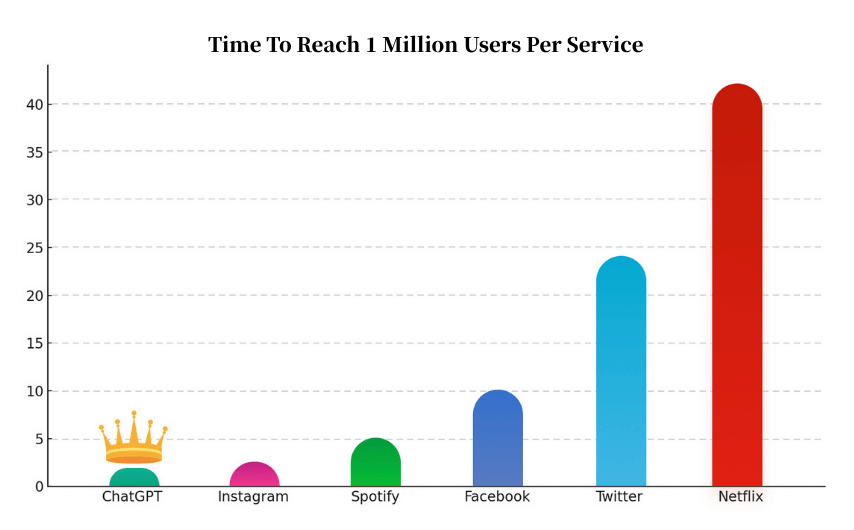
But ChatGPT is far more than just a “smarter search box.” It can chat with you, write copy, translate languages, polish your résumé, and even plan a customized travel itinerary. In many ways, it feels like an always-on, never-tired smart companion you can count on anytime.
Since its release, it has been continuously updated every few months, from the earliest model GPT3.5, which could only process text, to yesterday's GPT-4o, which could only view images, listen to sounds, and understand documents.
Impressive? Now, GPT-5 has also been released in August 2025. If you haven't truly experienced ChatGPT yet, now is a great time to start.
Introduction to the ChatGPT Interface
For first-time users, the initial reaction is often: “Isn’t this just a chat box?” And you’re right—the interface is designed to be clean and simple, much like using Facebook or any other messaging app. The only difference is that the “friend” you’re chatting with is an AI.
Let’s take the desktop web version as an example. The image below will give you a quick overview of the main parts of the ChatGPT interface so you can get familiar in seconds.
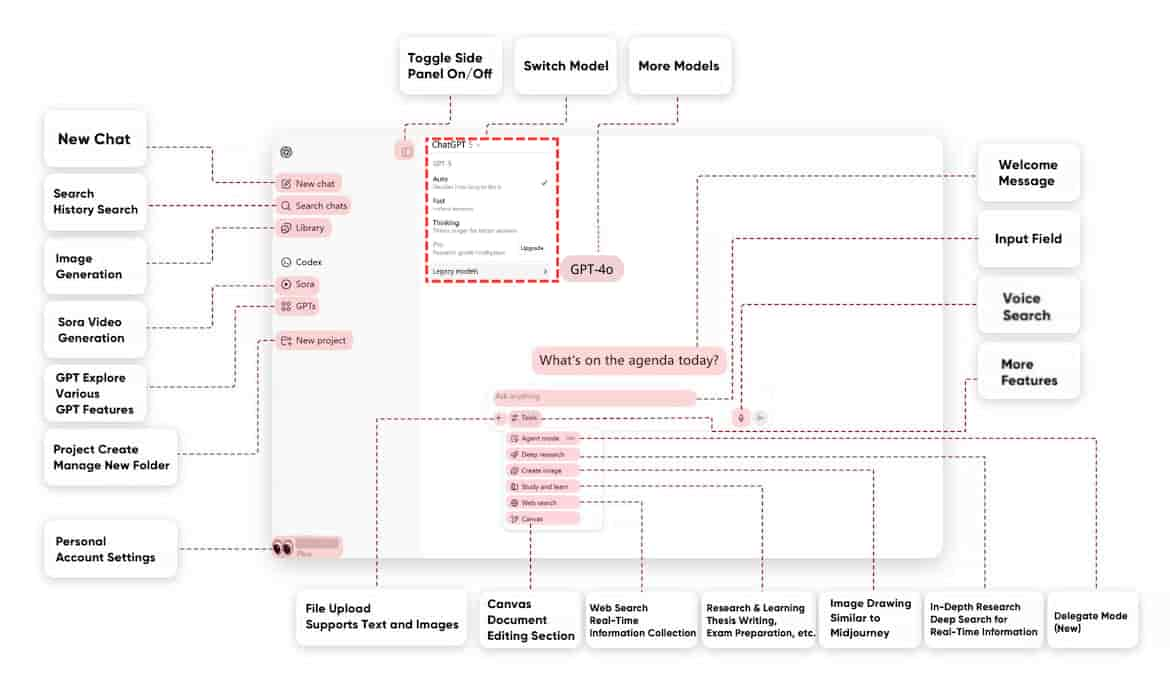
The ChatGPT interface is divided into three main sections: the left sidebar, the chat area in the middle, and the input box at the bottom.
Left Sidebar. Here you can start a brand-new conversation or browse through your past chat history. At the very bottom, you’ll find the settings panel, where you can adjust things like the interface theme, language, and which AI model you want to use.
Middle Chat Area. This is where all your conversations with ChatGPT happen. If you’ve used it for a while, you might have experienced a reply suddenly cutting off mid-sentence.
Don’t worry, this usually happens because ChatGPT has a character limit per message (about 4,000–4,500 characters). Simply type “continue”, and it will pick up right where it left off.
Bottom Input Box. This is where you give ChatGPT your “task instructions.” Just type your request and hit the send button, and it will respond instantly.
For example, if you want to ask about the launch time of NASA-SpaceX Crew-11, you can type your question just like in the example image, and ChatGPT will give you the answer right away.

With such a simple design, it’s like adding a knowledgeable, always-available AI companion right into your contacts list.
How to Use ChatGPT for Beginners?
Even if you’ve never tried AI before, you can experience the magic of ChatGPT in just a few minutes.
Create Your ChatGPT Account
The first step to using ChatGPT is creating an account.
Go to the official ChatGPT website and click the Sign Up button. You can register with your email address or sign in instantly using your Google, Apple, or Microsoft account.
Once you’ve signed up, simply enter your name and date of birth—and you’re ready to go. The whole process takes less than three minutes, and it’s incredibly easy.
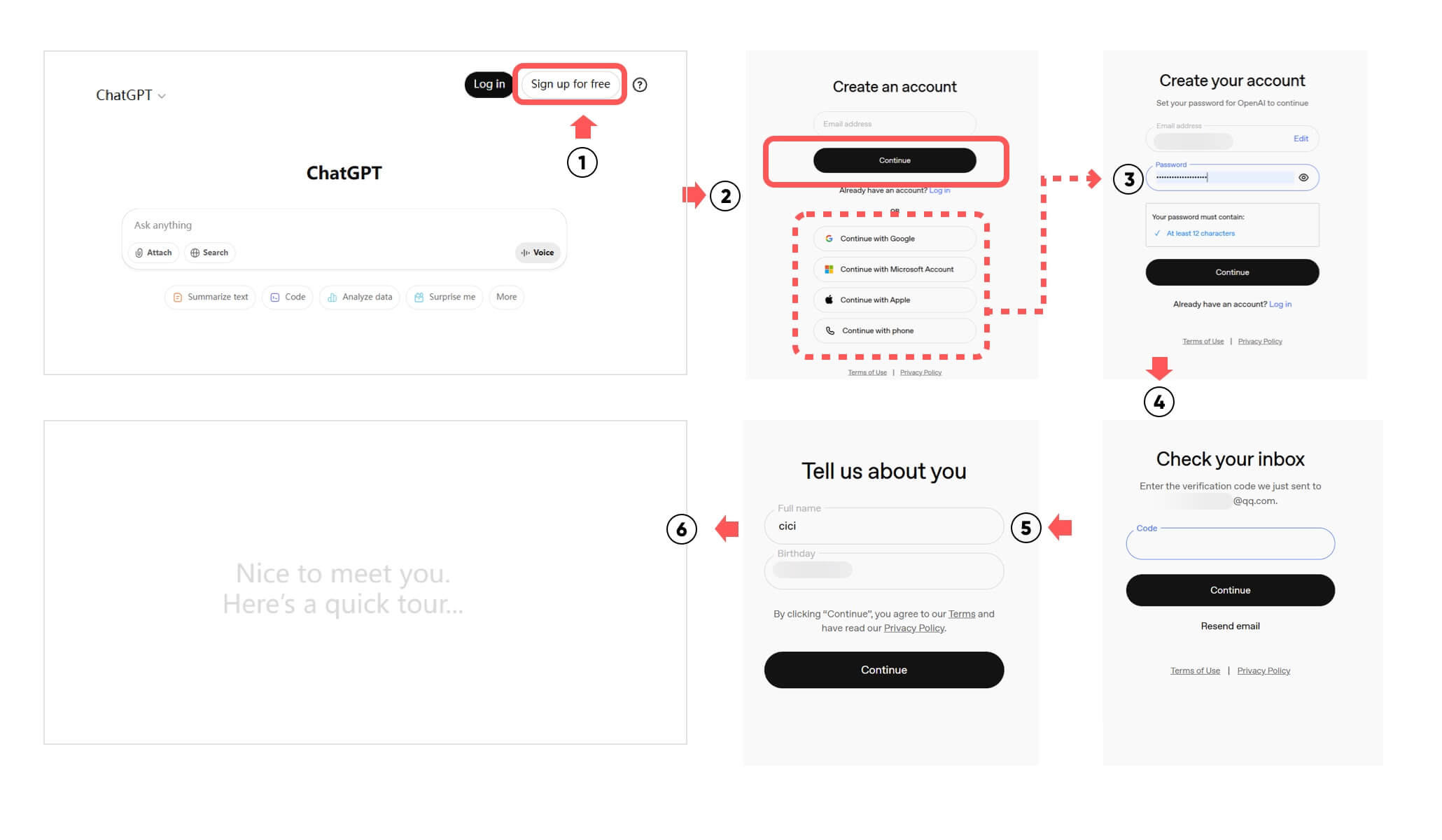
Choose the Right Model for You
With the release of Chat GPT 5, the original model selection method has been replaced by automatic identification of conversation content and automatic model activation. However, if your Chat GPT has not yet been updated, you will see several different model options on the interface.
Since launch, ChatGPT has gone through multiple upgrades, including:
GPT-3.5 – The default model for free users, first released in 2022. Best for simple, everyday tasks like casual conversation or basic writing edits. It’s fast and reliable, but has limitations when it comes to deeper reasoning or complex problem-solving.
GPT-4o – The default model for paid subscribers. Great for both daily and professional tasks, with added multimodal input—meaning it can process voice and images as well as text. Balances speed, accuracy, features, and cost.
GPT-4.1 – Has the best memory and can handle extremely long text—up to 1 million tokens. Perfect for reading research papers, contracts, or other lengthy documents. The lighter GPT-4.1-mini version offers similar performance at a lower cost, ideal for budget-conscious business users.
GPT-4.5 – The most human-like ChatGPT model so far. Compared to GPT-4o, it shows more visible reasoning steps and adds a touch of emotional nuance to its answers.
The “o” Series Models – Includes GPT-o3, GPT-o4-mini, and o4-mini-high. The “o” stands for omni (all-around).
GPT-o3 – Excels at logical reasoning, problem-solving, and coding—best for complex, logic-heavy tasks.
GPT-o4-mini & o4-mini-high – Lightweight models for everyday use, with built-in image generation. The o4-mini-high is the enhanced version, offering stronger visual capabilities for creating image-rich summaries, reports, or multimedia content.
The release of GPT 5 has made these models obsolete, but many users have reported that the latest GPT 5 does not seem to be as intelligent as before. Many users miss being able to choose their model.
Chatting with ChatGPT
Once you’ve chosen your model, you can start talking to ChatGPT right away. Just type your question in the input box, press Enter or click Send, and it will instantly respond.
But if you want its answers to be more accurate, useful, and tailored to your needs, there are a few simple tricks you can use.
Keep Your Structure Clear
Many people think ChatGPT gives inaccurate answers, but in most cases, it’s not because the AI isn’t smart—it’s because the instructions aren’t complete enough.
A very effective prompt format is: Background + Task + Requirements. This helps the AI understand who you are, what you want to do, and how you want it done.
Example:
I’m a new product manager (background). I need to write a competitor analysis report (task). Please create a detailed outline and recommend data sources (requirements).
Provide Background Information
Adding context and specific details can make a big difference. While ChatGPT has an enormous knowledge base, vague or overly broad questions make it harder for it to figure out exactly what you want.
Example:
Basic: Recommend a travel itinerary.
Improved: My friends and I are going to the U.S. next month for 4 days and 3 nights. We want a relaxed trip focused on food and Instagram-worthy spots. Our budget is limited, but we want clean and comfortable accommodation.
By giving more background, ChatGPT can better understand your intentions and give recommendations that truly match your needs.
Assigning Roles to ChatGPT
ChatGPT isn’t just a passive Q&A tool—it can respond from a specific perspective you set, like a high school math teacher, a market researcher, or any other role you choose.
This approach is perfect when you want advice or explanations from a certain point of view.
How to do it: Simply start your prompt with “You are a…”.
Example:
You are a high school math teacher. I can never figure out the direction of a quadratic function’s opening—can you explain it to me?
When you do this, ChatGPT will think and respond as if it were in that role. Often, it will be more patient than a real teacher—and won’t mind if you ask the same question ten times.
Give Examples
While ChatGPT is knowledgeable and highly capable with language, it’s still not human—it doesn’t always pick up on subtle hints. The fastest way to make it “get” your desired tone, style, or emotion is to give examples you like.
For instance, if you ask ChatGPT to write a polite “decline a blind date” message in Korean, it might produce something like:
I'm sorry, but this blind date will be difficult.
But if you provide examples, like:
I've been really busy at work lately... You seem like a nice person, but I don't think I can handle it.”
"Thanks for the introduction! Things are a bit complicated for me right now.
It will produce warmer, more natural replies:
I'm feeling a little overwhelmed lately, so I'm trying to be careful not to offend anyone.”
“Thank you for your interest! Right now, I feel more comfortable being alone than being introduced to someone new.
Use Feedback to Improve Its Responses
Under every ChatGPT reply, you’ll see a 👍 and 👎 button. Use these to tell ChatGPT whether you’re satisfied with its answer. A thumbs-up helps it learn your preferences, while a thumbs-down signals it to avoid similar responses next time.
The more feedback you give, the better ChatGPT will understand what you like. For frequent users, this is an easy way to make the AI work more in tune with your style.
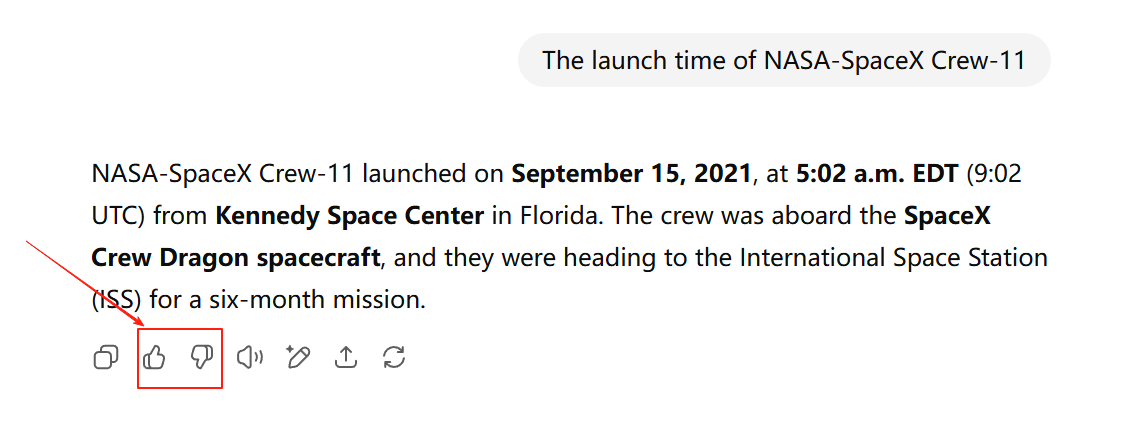
Requesting a New Answer
If you’re not satisfied with ChatGPT’s reply or want to see how another model would respond, simply use the option shown in the example image to regenerate the answer.
Sometimes, switching to a different model—or just trying again—can give you completely new insights and ideas.
In short, ChatGPT is easy to use. The key lies in how you ask questions and provide feedback. All these prompting tips serve one purpose: to help you ask ChatGPT a precise question. The clearer your conditions, the more accurate and relevant its answers will be.
What Other Features Does ChatGPT Have?
ChatGPT can do much more than just answer questions—it can also generate images, browse the internet, and even perform deep reasoning tasks.
Upload Files and Images
Uploading is simple. Just click the “+” icon in the chat box (as shown in the example image), and you can attach your files or pictures directly.
Currently, ChatGPT supports the most common file types, including:
PDF / Word / Excel / PPT – Quickly read documents, extract summaries, translate text, and analyze spreadsheets.
Images (JPG, PNG, etc.) – Recognize text in images, understand their content, and even create captions or copy based on the image.
Code files (.py, .js, etc.) – Identify bugs, analyze logic, and suggest optimizations.
At the moment, ChatGPT does not support uploading compressed files (e.g., .zip) or audio/video files (e.g., .mp3, .mp4).
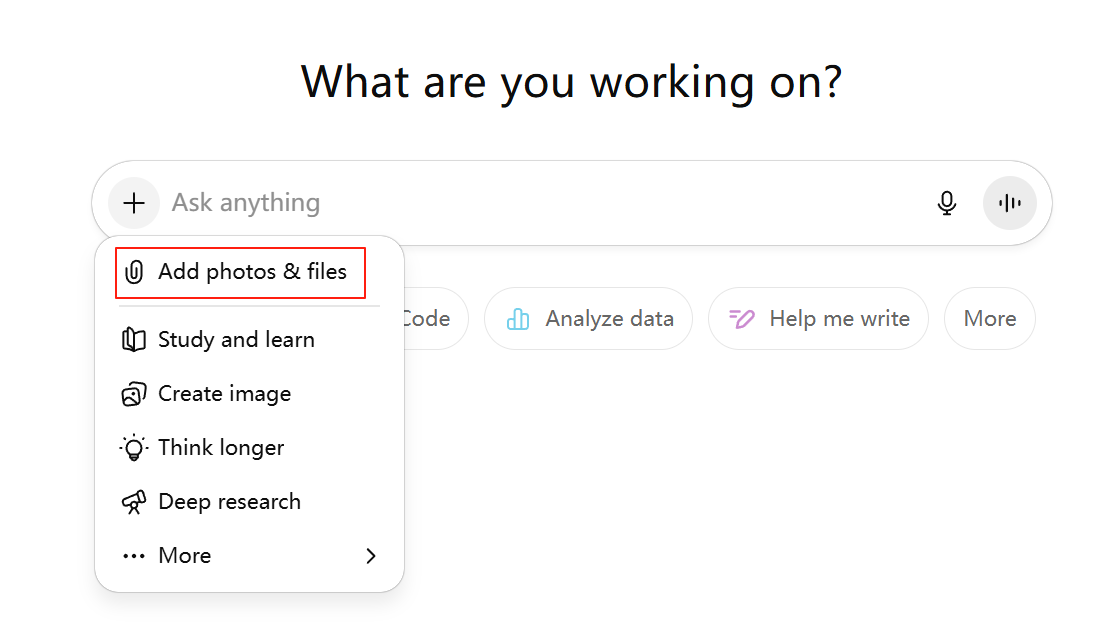
Web Browsing
The web browsing feature gives ChatGPT real-time internet access, solving the problem of AI answers sometimes being out of date. Once enabled, ChatGPT can search the vast web for information and deliver clear, well-organized answers.
The results are neatly broken down into logical bullet points, saving you time both in searching for information and reading through it. Plus subscribers and above get access to more comprehensive and detailed search results with this feature.
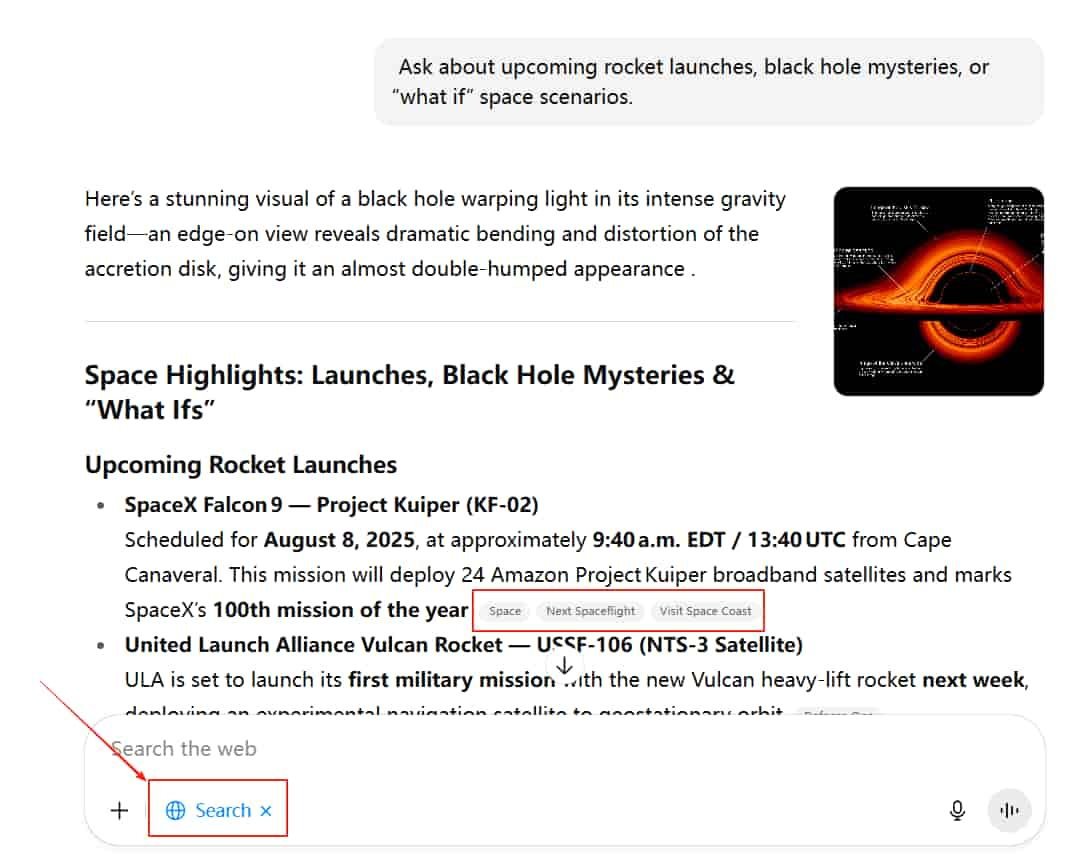
Deep Research
The Deep Research feature is essentially an upgraded version of ChatGPT’s web browsing. It pulls information from official websites, professional sources, and reputable blog articles—then compiles it into a well-structured, evidence-backed answer.
Its biggest advantage is that every statement includes a citation, making the content far more trustworthy. This is especially useful for data collection, market research, literature reviews, and other tasks where accuracy matters.
Because it processes a large volume of information, responses may take a bit longer to generate. Plus subscribers can use Deep Research up to 25 times per month, while free users get 5 uses per month.
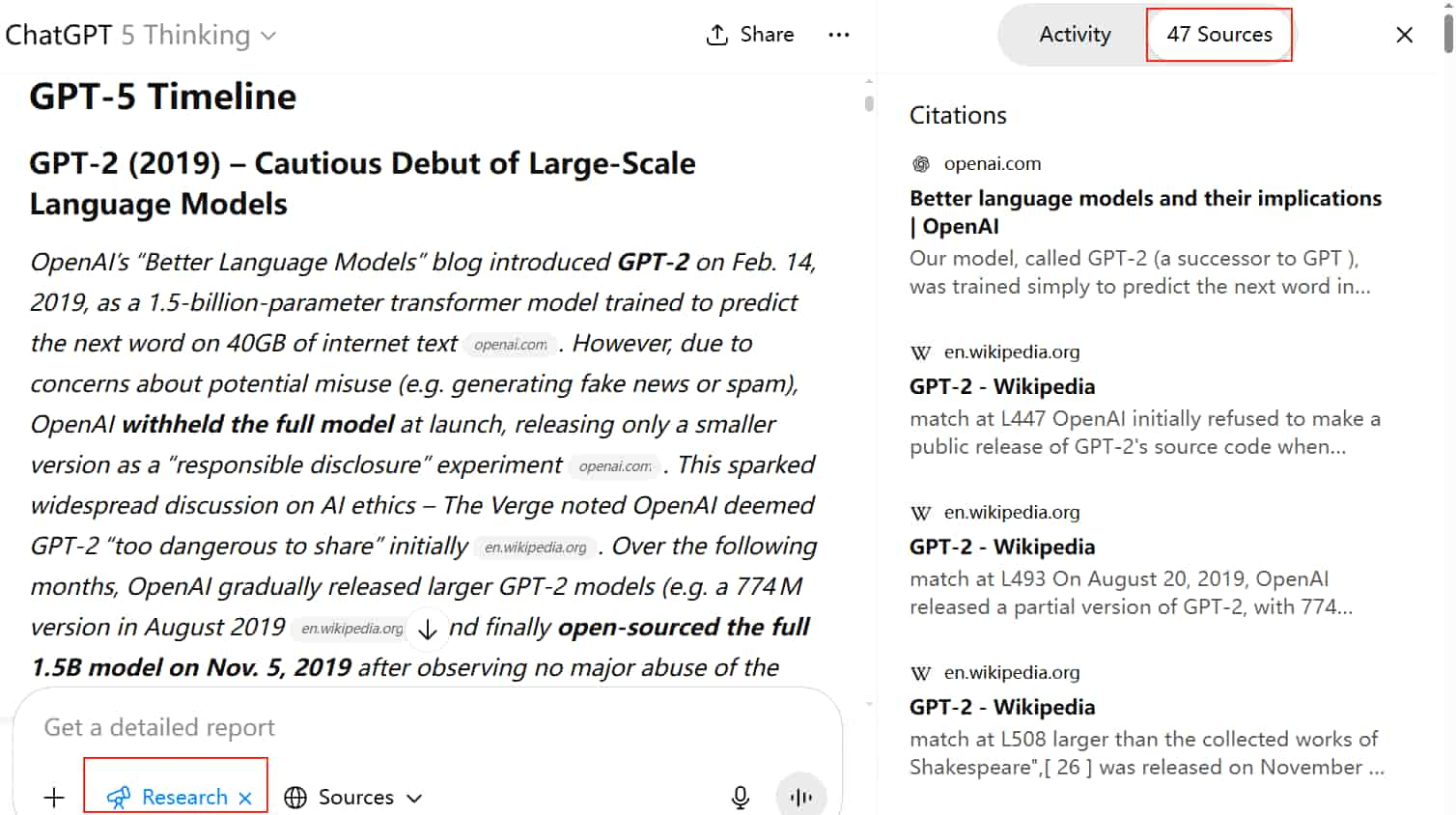
Image Generation
ChatGPT’s image generation feature became available after the upgrade to the GPT-4o model. Powered by OpenAI’s DALL·E 3 technology, it can produce realistic, high-quality images in a wide variety of styles—making it a strong alternative to Midjourney.
Using it is simple: just type a prompt describing the image you want, and ChatGPT will quickly create it. You can also refine the result through conversation—adjusting composition, changing the background, or even replacing specific elements in the scene.
Best of all, everything can be done directly in chat, making the process intuitive and interactive.
This feature is also available to free ChatGPT users, though limited to 2 images per day. Paid users enjoy unlimited image generation. For the best results, try to write your prompts in clear English, as this improves accuracy and ensures the generated image matches your expectations.
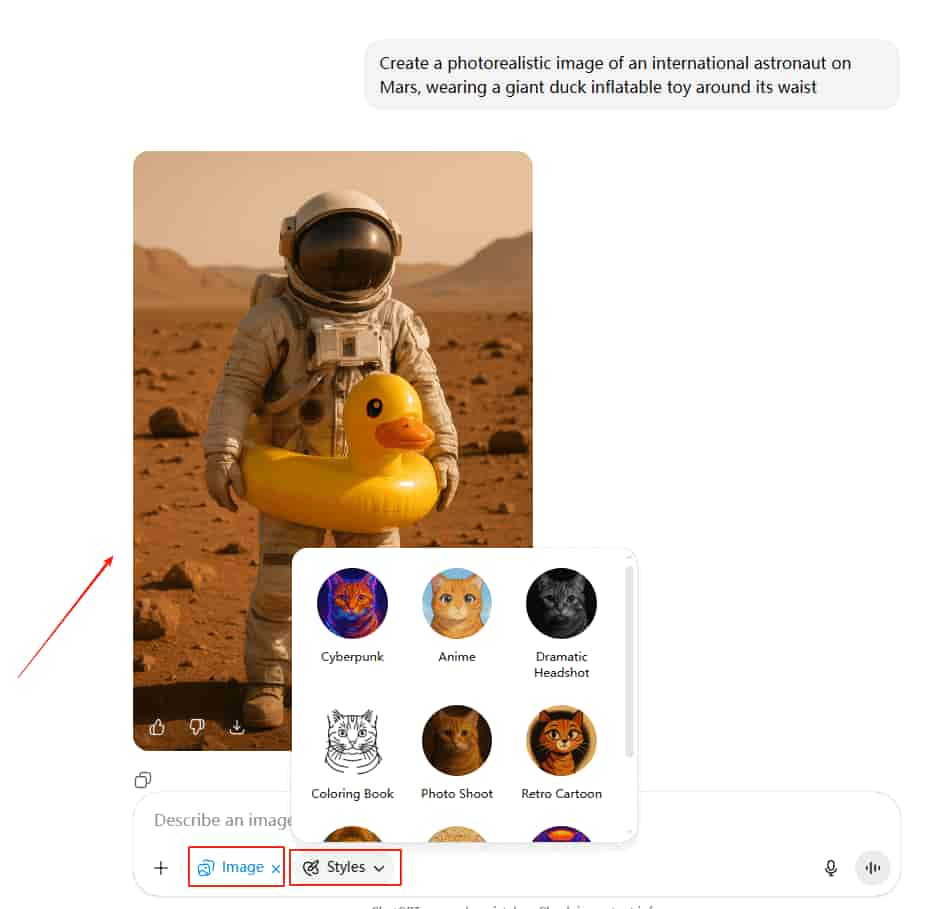
Canvas
ChatGPT now integrates document editing directly into its interface, and Canvas is the built-in collaborative workspace.
When you’re writing an article or conducting research, you can ask ChatGPT to open a document workspace in the sidebar. This lets you easily review and edit AI-generated content—either by making changes yourself or by asking ChatGPT to edit it for you.
For example, if you’re drafting an article, you can say: “Please check and correct the grammar errors in the second paragraph.” ChatGPT will instantly update the shared document in real time.
You can open Canvas in two ways: Manually by selecting it yourself. Automatically, when ChatGPT detects a relevant request—such as “Write an article for me” or “Generate a blog paragraph.”
Temporary Chat
You can start a temporary conversation with ChatGPT at any time. Just click New Chat, then tap the Temporary Chat icon in the top right corner.
This mode works like your browser’s incognito mode—your conversation won’t be saved or appear in your chat history. Once you close the window, the conversation is gone for good.
If you value privacy and don’t want to leave any usage traces, this feature is a simple and effective solution.

Voice Input
If you don’t feel like typing, ChatGPT also supports voice input. Simply speak into your phone or computer, and ChatGPT will instantly convert your speech into text and reply to you.
The advanced voice features are currently available only to paid users of the GPT-4o model. In this mode, ChatGPT can not only listen to you but also respond with AI-generated speech—engaging in real-time, natural conversations without long waits, just like talking to a real person.
Customizing ChatGPT
If you're using the paid version of ChatGPT, you can customize your ChatGPT.
This feature allows you to "teach" ChatGPT to understand you better, such as who you are, how you like it to talk, how it should respond to your questions, and so on.
How to set it up? Open the ChatGPT chat interface, click your profile picture or username in the lower left corner, select Customize Commands, fill in the information in the image, and save. ChatGPT will then begin interacting with you according to your settings.
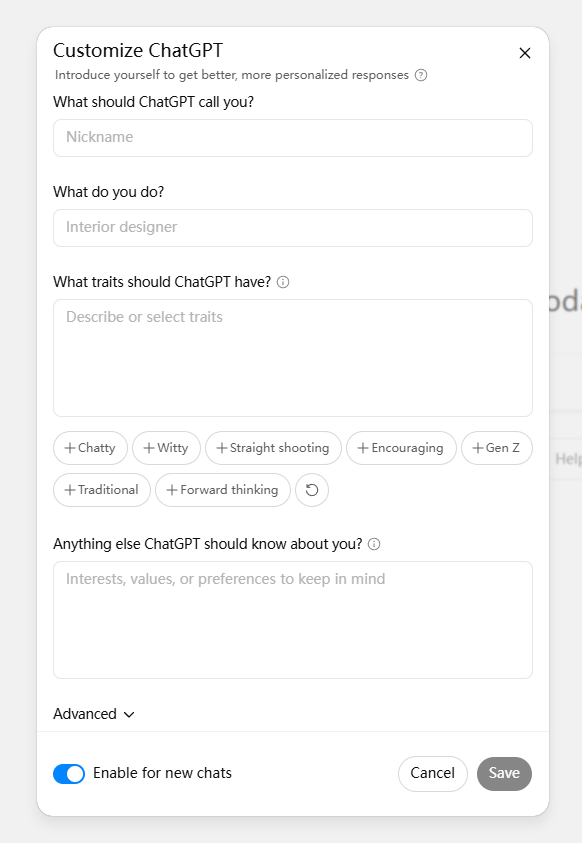
Free vs. Plus ChatGPT: What’s the Difference?
While ChatGPT is free to use, there’s also a paid version. So, what exactly does the paid plan offer? Is ChatGPT really worth the $20 subscription fee?
The table below highlights the key differences between the free and paid versions, so you can quickly decide which one is right for you.
| Feature | Free | Plus ($20 / month) | GamsGo |
| Price | $0 / month | $20 / month | $7/month |
| Default model | GPT-4o mini | GPT-4o | GPT-4o |
| Additional models | GPT-4o miniGPT-4o (limited use) | All models except o1 pro | All models except o1 pro |
| Sora (video generation) | ✖ | Limited access | Limited access |
| Advanced voice mode | Up to 15 minutes per session | ✅ No time limit | ✅ No time limit |
| Image generation | Limited quota | Unlimited | Unlimited |
| Web browsing | ✅ | ✅ | ✅ |
| File uploads | Limited | Unlimited | Unlimited |
| Canvas | ✅ | ✅ | ✅ |
| Projects | ✖ | ✅ | ✅ |
| Deep Dive | 5 per month | 25 per month | 25 per month |
Currently, GPT-4o is recognized as one of the most advanced models available. Free users can only access GPT-4o a limited number of times—once that limit is reached, the system switches to GPT-4o mini, which delivers a reduced experience.
However, even subscribing to ChatGPT Plus doesn’t guarantee a completely worry-free experience. The Plus plan still comes with certain limits—such as restrictions on deep reasoning requests, occasional slowdowns or delays during peak hours, and of course, the relatively high monthly cost.
That’s why many ChatGPT Plus users look for more stable and cost-effective alternatives. GamsGo is a trusted subscription-sharing platform that offers multiple affordable ways to access ChatGPT Plus, including official ChatGPT Plus recharge services, and shared subscriptions—so you can enjoy premium AI at a fraction of the price.
Ready to Start With ChatGPT?
From signing up and choosing the right model to mastering conversation tips, uploading files, browsing the web, generating images, and understanding subscription options—you now have a complete picture of how ChatGPT works.
In truth, ChatGPT isn’t complicated. The key is to experiment, ask boldly, and make the most of its abilities. With the right approach, it can become one of your most powerful personal and professional assistants.
And if you want to unlock its full potential and upgrade to ChatGPT Plus at a smarter price, GamsGo is a cost-effective option worth considering.
Now is the time to turn ChatGPT from something you’ve heard about into a tool you can use with confidence. Start today, and make ChatGPT your secret weapon for productivity and career growth.
FAQ
Does ChatGPT look at your chats?
OpenAI may use sample ChatGPT conversations to improve its models. You can turn this off in the settings to prevent your conversations from being stored or used for training. This is something other AI tools like Claude cannot do.
Can I use ChatGPT for free?
Yes, you can use ChatGPT for free. However, there is a limit on how many times you can use advanced models like GPT-4o. Once you have used up your limit, you can continue using 4.1 mini for free, or upgrade to ChatGPT Plus to continue using GPT-4o.
How do I use ChatGPT on my phone?
To use ChatGPT on your phone, visit ChatGPT.com in your mobile browser or download the ChatGPT app from the iOS App Store or Google Play Store. Log in with your account and start chatting just like on your desktop—type, voice input, upload files, and even generate images (if your plan supports it).

